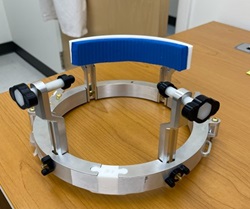Towards Pin-less and Non-invasive Low-intensity MR Guided Focused Ultrasound (MRgFUS) Treatments: Development, Testing and Clinical Implementation of Maryland MR Head and Neck Restrainer System
$125,000 Award
Project Overview
Our project aims to markedly expand indications of low frequency and mid-frequency applications of MR Guided ultrasound. We hope to achieve this by making the head frame completely painless for the patient and normal human volunteers and thereby eliminate frame related considerations from new clinical trials for blood brain barrier disruption and neuromodulation. We have a rough prototype in place and there is ongoing work on creating an IRB application for testing this in volunteers for adequate head stability.
Project Team
- Dheeraj Gandhi, MD, Radiology
- Graeme Woodworth, MD, Neurosurgery
- Benjamin Pierce, Radiology (MRI)
- Kelsey Norfolk, Radiology (MRI)
- Alex Young, Radiology (MRI)
- Pamela Janocha, Interventional Radiology
- Timothy Miller, Radiology
- Sijia Guo, Radiology
- Rao Gullapalli, Radiology
- Ranyah Almardawi, DISPA Radiology
June 2022 Updates
We have developed a prototype of novel MR guided focused ultrasound fixation system that is versatile for low and mid frequency applications and does not require pinning for cranial fixation. There are soft paddles and pillars that stabilize the head during the sonication cycles. Based on preliminary testing, the frame can restrain the head with less than 1.7mm of translation or craniocaudal motion, an acceptable metric for low and mid frequency applications.
An IRB application is currently under review to start testing the prototype in normal volunteers.
Project Outcomes

Dr. Gandhi and team have successfully developed a pin-less MR guided focused ultrasound treatment device. Volunteer testing is still underway, but preliminary results have shown significant promise.
Dr. Gandhi and team will continue to test the prototype device, with plans to move to clinical trial. Once the results of complete volunteer testing are published, the team plans to obtain a full patent and approach FDA for device approval.
Potential benefits of the ultrasound device include new clinical trials for neuromodulation, including neuropathy pain, epilepsy, drug addiction, major depression and OCD. Additionally, there are considerations for use for brain mapping to understand neuronal circuits in thalamus and basal ganglia.
